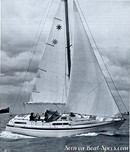Moody 36 - Primrose
Sailboat specifications
The Moody 36 - Primrose is a 36’ (10.97m) cruising sailboat designed by Angus Primrose (United Kingdom). She was built between 1977 and 1981 by Moody (United Kingdom).
Moody 36 - Primrose's main features
- Model
- Moody 36 - Primrose
- Hull type
- Monohull
- Category
- Coastal cruising sailboat
- Sailboat builder
- Sailboat designer
- Country
- United Kingdom
- Construction
- GRP (glass reinforced polyester):
- Hull: Single skin fiberglass polyester
- Deck: Single skin fiberglass polyester - First built hull
- 1977
- Last built hull
- 1981
- Appendages
- Keel : fin without bulb
- Helm
- Single helm wheel
- Rudder
- Single rudder on skeg
- Unsinkable
- No
- Trailerable
- No
- EC design categoryiThe CE design category indicates the ability to cope with certain weather conditions (the sailboat is designed for these conditions)
A: Wind < force 9, Waves < 10m
B: Wind < force 8, Waves < 8m
C: Wind < force 6, Waves < 4m
D: Wind < force 4, Waves < 0,5m - 1
- Standard public price ex. VAT (indicative only)
- N/A €
Moody 36 - Primrose's main dimensions
- Hull length
- 36’10.97 m
- Waterline length
- 30’9.14 m
- Beam (width)
- 12’ 4”3.76 m
- Draft
- 5’1.52 m
- Light displacement (MLC)
- 14700 lb6668 kg
Moody 36 - Primrose's rig and sails
- Upwind sail area
- 710 ft²65.97 m²
- Mainsail area
- 243 ft²22.58 m²
- Genoa area
- 467 ft²43.39 m²
- Jib area
- 263 ft²24.43 m²
- Stormjib area
- 94 ft²8.73 m²
- Rigging type
- Sloop Marconi masthead
- Mast configuration
- Deck stepped mast
- Rotating spars
- No
- Number of levels of spreaders
- 1
- Spreaders angle
- 0 °
- Spars construction
- Aluminum spars
- Standing rigging
- 1x19 strand wire continuous
Moody 36 - Primrose's performances
- Upwind sail area to displacementiThe ratio sail area to displacement is obtained by dividing the sail area by the boat's displaced volume to the power two-thirds.
The ratio sail area to displacement can be used to compare the relative sail plan of different sailboats no matter what their size.
Upwind: under 18 the ratio indicates a cruise oriented sailboat with limited performances especially in light wind, while over 25 it indicates a fast sailboat. - 200 ft²/T18.62 m²/T
- Displacement-length ratio (DLR)iThe Displacement Length Ratio (DLR) is a figure that points out the boat's weight compared to its waterline length. The DLR is obtained by dividing the boat's displacement in tons by the cube of one one-hundredth of the waterline length (in feet).
The DLR can be used to compare the relative mass of different sailboats no matter what their length:
a DLR less than 180 is indicative of a really light sailboat (race boat made for planning), while a DLR greater than 300 is indicative of a heavy cruising sailboat. - 247
- Critical hull speediAs a ship moves in the water, it creates standing waves that oppose its movement. This effect increases dramatically the resistance when the boat reaches a speed-length ratio (speed-length ratio is the ratio between the speed in knots and the square root of the waterline length in feet) of about 1.2 (corresponding to a Froude Number of 0.35) . This very sharp rise in resistance, between speed-length ratio of 1.2 to 1.5, is insurmountable for heavy sailboats and so becomes an apparent barrier. This leads to the concept of "hull speed".
The hull speed is obtained by multiplying the square root of the waterline length (in feet) by 1.34. - 7.34 knots
Moody 36 - Primrose's auxiliary engine
- Engine(s)
- 1 inboard engine
- Engine(s) power
- 40 HP
- Fuel type
- Diesel
- Fuel tank capacity
- 60 gal227 liters
Moody 36 - Primrose's accommodations and layout
- Cockpit
- Center cockpit
- Cabin(s)
- 2
- Berth(s) (min./max.)
- 4 / 7
- Head(s)
- 2
- Freshwater tank capacity
- 72.1 gal273 liters
Moody 36 - Primrose's saloon
- Berth length
- 6’ 5”1.95 m
Moody 36 - Primrose's fore cabin
- Maximum headroom
- 6’ 2”1.88 m
- Berth length
- 6’ 4”1.93 m
Similar sailboats that may interest you:
Sailboats
First built hull
Hull length
1984
37’11.28 m
1983
38’ 6”11.73 m
1971
30’9.14 m
1970
33’ 8”10.26 m
1982
36’ 4”11.07 m
1985
32’ 10”10 m
1979
33’10.06 m
1985
32’ 10”10 m
1978
34’ 7”10.54 m
2006
34’ 10”10.6 m
1981
34’ 11”10.65 m
1971
35’ 2”10.72 m
1994
37’ 1”11.31 m
1974
37’ 5”11.4 m
1979
39’ 2”11.95 m

